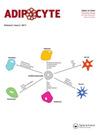T-stage-specific abdominal visceral fat, haematological nutrition indicators and inflammation as prognostic factors in patients with clear renal cell carcinoma
IF 3.1
4区 生物学
Q2 ENDOCRINOLOGY & METABOLISM
引用次数: 1
Abstract
ABSTRACT Clear cell renal carcinoma (ccRCC) is the most common histological type of renal cancer and has the highest mortality. Several studies have been conducted on the relationship between adipose tissue and ccRCC prognosis, however, the results have been inconsistent to date. The current study aimed at establishing a link between abdominal fat composition and short-term prognosis in patients with ccRCC after T-stage stratification. We retrospectively analysed 250 patients with pathologically confirmed ccRCC (173 low T-stage and 77 high T-stage) in our hospital. The computed tomography (CT) images were evaluated using ImageJ. Then, subcutaneous and visceral fat areas (SFA and VFA), total fat areas (TFA) and the relative VFA (rVFA) were measured and computed. Meanwhile, biochemical indices of blood serum were analysed. The results showed that rVFA in low T-stage cohort who had a history of short-term postoperative complications were significantly lower than those who did not. No such association was observed in the high T-stage cohort. Further investigation revealed that the correlations between biochemical indexes and fat area-related variables varied across T-stage groups. As a result, rVFA is a reliable independent predictor of short-term prognosis in patients with low T-stage ccRCC but not in patients with high T-stage ccRCC.明确肾细胞癌患者t期特异性腹部内脏脂肪、血液学营养指标和炎症作为预后因素
透明细胞肾癌(ccRCC)是肾癌中最常见的组织学类型,死亡率最高。一些关于脂肪组织与ccRCC预后关系的研究已经开展,然而,迄今为止,结果并不一致。目前的研究旨在建立腹部脂肪组成与t期分层后ccRCC患者短期预后之间的联系。我们回顾性分析了我院250例经病理证实的ccRCC患者(173例低t期,77例高t期)。使用ImageJ对CT图像进行评价。然后测量并计算皮下和内脏脂肪面积(SFA和VFA)、总脂肪面积(TFA)和相对脂肪面积(rVFA)。同时对血清生化指标进行分析。结果显示有术后短期并发症史的低t期队列rVFA明显低于无术后短期并发症史的低t期队列rVFA。在高t期队列中没有观察到这种关联。进一步的研究发现,生化指标与脂肪面积相关变量之间的相关性在不同的t期组中有所不同。因此,rVFA是低t期ccRCC患者短期预后的可靠独立预测因子,而不是高t期ccRCC患者的预测因子。
本文章由计算机程序翻译,如有差异,请以英文原文为准。
求助全文
约1分钟内获得全文
求助全文
来源期刊

Adipocyte
Medicine-Histology
CiteScore
6.50
自引率
3.00%
发文量
46
审稿时长
32 weeks
期刊介绍:
Adipocyte recognizes that the adipose tissue is the largest endocrine organ in the body, and explores the link between dysfunctional adipose tissue and the growing number of chronic diseases including diabetes, hypertension, cardiovascular disease and cancer. Historically, the primary function of the adipose tissue was limited to energy storage and thermoregulation. However, a plethora of research over the past 3 decades has recognized the dynamic role of the adipose tissue and its contribution to a variety of physiological processes including reproduction, angiogenesis, apoptosis, inflammation, blood pressure, coagulation, fibrinolysis, immunity and general metabolic homeostasis. The field of Adipose Tissue research has grown tremendously, and Adipocyte is the first international peer-reviewed journal of its kind providing a multi-disciplinary forum for research focusing exclusively on all aspects of adipose tissue physiology and pathophysiology. Adipocyte accepts high-profile submissions in basic, translational and clinical research.
 求助内容:
求助内容: 应助结果提醒方式:
应助结果提醒方式:


